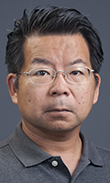Architecture students travel to Bangladesh, win design charrette

Koichiro Aitani
A master plan for transforming a polluted industrial area in Dhaka, Bangladesh into a vibrant community with schools, markets and homes — designed in-part by two Texas A&M Master of Architecture students — earned first place honors at a four-day design charrette held last August at [Bangladesh University of Engineering and Technology] (http://one.arch.tamu.edu/news/2012/4/30/aggie-architecture-bangladesh/) .
Texas A&M students Erik Larsen and Wendy Weatherly were part of the winning international design team that included students from Virginia Tech, Kyushu University, Chinese Culture University and the host school — one of four teams competing in Sustainable Design Camp, an annual event funded by Kyushu University Research Institute of East Asia Environments.
The Department of Architecture paid for five graduate Texas A&M architecture students to travel to Dhaka for the charrette, which included 50 participants who were guided through the competition by faculty from participating schools, including Koichiro Aitani, associate professor of architecture at Texas A&M.
The competition sought solutions for a government initiative in Dhaka’s Hazaribagh district where up to 95% of the registered tanneries in Bangladesh are located. Most use outdated processing methods and, according to Time magazine, which listed the area among “The World’s 10 Most Polluted Places,” the tanneries dump 22,000 cubic liters of toxic waste each day, including the cancer-causing toxin hexavalent chromium, into the city’s Buriganga River.
“Tannery workers in Hazaribagh live on top of contaminated streams and canals, while informal recyclers burn scraps of leather, further polluting the air,” according to the Time [article] (http://science.time.com/2013/11/04/urban-wastelands-the-worlds-10-most-polluted-places/slide/hazaribagh-bangladesh/) . As a result, residents face elevated rates of skin and respiratory diseases, as well as acid burns, rashes, dizziness and nausea.
“Rapid urbanization has turned Dhaka into concrete jungle/slum areas with little open space and inadequate road areas,” said the Sustainable Design Camp project briefing, adding that proper land use, regeneration and improvement to different parts of the city is essential to healthy living.
For the design charrette, the Texas A&M students, who also included Minkeun Sim, Kasi Svoboda and Shan Wang, were mixed into four teams with their international counterparts, including students from landscape architecture, urban planning and civil engineering programs. Each team was asked to create a master plan for the 134-acre site reimagined without the tanneries and including restoration of the contaminated soil.
Students began with an onsite inventory, reviewing the buildings and collecting relevant data about the population, traffic patterns and economic and environmental characteristics. Once informed, they had two days to craft their plan, build models and otherwise hone their final presentations.
The best proposal, as selected by a jury of charrette faculty and student participants, called for using green plants and their associated microorganisms to restore the site’s contaminated soil in a process known as [phytoremediation] (http://www.epa.gov/superfund/accomp/news/phyto.htm) . The technique, first tested at a waste site in the early 1990s, has since been used at more than 200 sites in the U.S.
Students identified fast-growing and easy-to-plant sunflowers, [vetiver] (http://en.wikipedia.org/wiki/Chrysopogon_zizanioides) and [Indian mustard] (http://en.wikipedia.org/wiki/Brassica_juncea) as plants that are suitable for the climate, compatible with the soil, easy to maintain and able to quickly extract or degrade the soil’s contaminants.
In keeping with the city’s density regulations, the winning plan divided the district into 101 acres for commercial, recreational and institutional uses and 33 acres for residential areas plotted on a revamped roadmap. Responding to residents’ wishes, the students proposed a mix of schools, residences and employment-generating retail businesses.
Additionally, Aitani said, the winning plan identified buildings fit for [adaptive reuse] (http://adaptivereuse.net/about-adaptive-reuse/) and others destined for demolition.
All four master plans from the charrette will be polished and submitted to policymakers in Bangladesh and consolidated into a book scheduled for publication later this year, said Aitani, a regular participant in the Sustainable Design Camps previously held in Hong Kong, Indonesia, Sri Lanka and Vietnam.
Aitani said he is putting together a group for next year’s camp and hopes to add landscape architecture and urban planning students to Texas A&M’s 2015 participants.
The 2014 charrette host, Bangladesh University of Engineering and Technology, was [founded] (http://one.arch.tamu.edu/news/2012/4/30/aggie-architecture-bangladesh/) in 1961 by Dik Voorman ’52, a Texas A&M architecture professor, fellow former student James Walden ’55 and Dan Dunham, an architect with Berger Engineers.
Tags
- academics
- arch gallery
- architecture
- archone gallery
- coa gallery
- competitions
- global college
- graduate work
- hazards
- interdisciplinary
- land development
- land resources
- outreach
- partnerships
- planning
- rss
- studio projects
- sustainability
- transportation
- urban systems
Related Posts

Students creating high-density plans for Texas A&M

BED student designs 'Real Projects' home

Students create new designs for children’s treatment center
Follow Us
Facebook Twitter Vimeo Youtube Flickr RSS
Recent Posts

Planning prof heads study of disaster housing aid

A message from the dean

Former student remembered as expert planner

Leading educator named new head of Architecture Dept.















_thumbnail_small.png)
